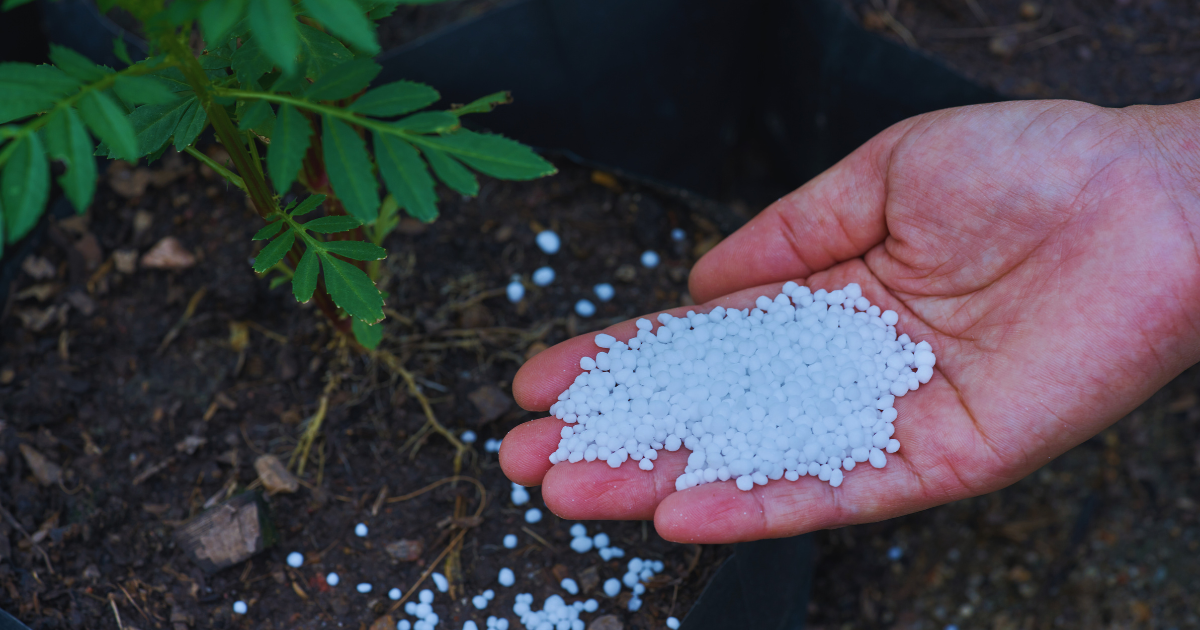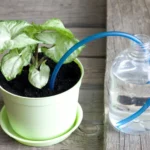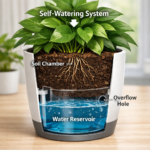Plants, like all living organisms, rely on a delicate balance of nutrients to thrive. Among these, calcium plays a crucial role in maintaining plant health. Often overlooked, calcium is essential not only for cell wall structure but also for various physiological processes. One of the key functions of calcium is its potential to aid in water retention within plants. This aspect is particularly important for gardeners and farmers looking to optimize plant hydration and resilience, especially during periods of drought or water scarcity. But how exactly does calcium help plants retain water?
In this article, we will explore the science behind calcium’s role in plant water retention, examining how this vital nutrient can contribute to healthier, more robust plant growth. Whether you’re an avid gardener or a curious reader, understanding the importance of calcium can help you better care for your plants and ensure they stay hydrated and firm.
Role of nutrients in plant health

Nutrients are essential for plant health, as they support vital physiological processes. Macronutrients like nitrogen, phosphorus, and potassium are crucial for growth, energy transfer, and overall plant development. Nitrogen is key for chlorophyll production, which drives photosynthesis. Nutrients are crucial for plant health, supporting essential physiological processes. Macronutrients like nitrogen, phosphorus, potassium, and calcium play key roles. Nitrogen is vital for chlorophyll production, driving photosynthesis.
Phosphorus aids root development and energy transfer, while potassium regulates water balance and enzyme activity.
Calcium is essential for cell wall structure, ensuring plant rigidity and stability. It also aids in cell division and helps plants respond to environmental stresses. Though needed in smaller amounts, micronutrients like iron, manganese, and zinc are critical for enzyme function and overall plant health. A balanced supply of these nutrients is essential for optimal growth, disease resistance, and high plant yield.
What is Calcium?

Calcium is a vital macronutrient that plays several essential roles in plant growth and development. It is an integral part of the cell wall structure, where it helps to maintain the rigidity and stability of plant cells. This structural role is crucial for supporting the plant’s physical framework, allowing it to stand upright and resist external pressures.
In addition to its structural functions, calcium is involved in various physiological processes. It is a secondary messenger in cellular signaling, regulating essential activities such as enzyme function and membrane permeability. Calcium ions help stabilize cell membranes and regulate ion exchange, critical for nutrient uptake and water transport.
Without adequate calcium, plants can suffer from various deficiencies and disorders. For example, a lack of calcium can weaken cell walls, resulting in symptoms like blossom end rot in tomatoes and tip burn in lettuce. These issues affect the plant’s overall health and can significantly reduce crop quality and yield.
Why is Calcium Important for Plants?
Calcium is essential for plants due to several key reasons:
- Structural Integrity
- Calcium strengthens cell walls by binding with pectins, creating a rigid matrix that supports the plant’s physical structure.
- This reinforcement prevents cells from collapsing, helping plants maintain their shape and stand upright.
- Cellular Communication
- Acts as a signaling molecule, enabling plants to respond to environmental changes and regulate vital functions like cell division and growth.
- Essential for the proper development and functioning of plant tissues.
- Nutrient Uptake and Transport
- Helps maintain the integrity of cell membranes, controlling the movement of ions and water into and out of cells.
- This regulation is crucial for nutrient uptake and the maintenance of turgor pressure, which keeps cells firm and hydrated.
- Prevention of Deficiencies
- Insufficient calcium can lead to common plant issues like blossom end rot in fruits and tip burn in leaves, affecting overall health and productivity.
- Ensures that plants are more resilient to diseases and environmental stressors.
How does calcium support plant growth?
Calcium plays a vital role in plant growth and development. It is an essential component of cell walls, providing structural support and rigidity. By stabilizing the cell wall, calcium helps maintain cell integrity, preventing collapse and allowing the plant to withstand environmental stresses. Additionally, calcium acts as a secondary messenger in cellular signaling pathways, regulating cell division and elongation processes, which are crucial for growth. It is involved in forming root hairs, which increase the surface area for nutrient and water absorption. Furthermore, calcium aids in regulating ion transport and balance within the plant, helping to control nutrient uptake and preventing the toxic accumulation of specific ions.
A deficiency in calcium can lead to various physiological disorders, such as blossom end rot in tomatoes and tip burn in lettuce, characterized by the breakdown of tissues. Therefore, an adequate supply of calcium is essential for healthy plant growth, development, and overall vitality.
Read to know: When to plant tomato seeds indoors? Tips and tricks
What are the signs of calcium deficiency?

Signs of calcium deficiency in plants typically manifest in new growth since calcium is relatively immobile within the plant. Key symptoms include:
- Leaf Deformation: Young leaves may appear distorted, curled, or misshapen. They can also exhibit a lighter color, sometimes turning yellow.
- Necrosis: The tips and edges of leaves may develop brown, dead spots, a condition known as necrosis. This is particularly common in young leaves and new shoots.
- Blossom End Rot: In fruits like tomatoes and peppers, calcium deficiency can cause the bottom of the fruit to develop dark, sunken spots, a condition called blossom end rot.
- Tip Burn: In leafy vegetables such as lettuce, the tips of leaves may turn brown and dry out.
- Poor Root Development: Affected plants may have underdeveloped or damaged root systems, impacting their overall growth and nutrient uptake.
- Stunted Growth: General stunting of the plant’s growth, with smaller leaves and shorter stems, may occur.
What are the sources of calcium for plants?
Plants obtain calcium from various sources in the soil. Key sources include:
- Limestone (Calcium Carbonate): This is a common soil amendment used to raise soil pH and provide a steady supply of calcium. Ground limestone is often used in agriculture.
- Gypsum (Calcium Sulfate): Gypsum provides calcium without altering soil pH. It is beneficial in soils that already have adequate pH but need additional calcium.
- Calcium Nitrate: This fertilizer supplies both calcium and nitrogen. It’s quickly absorbed by plants and is commonly used in hydroponic systems or as a foliar spray.
- Dolomitic Lime: This compound contains both calcium carbonate and magnesium carbonate, providing a source of calcium and magnesium. It’s often used to correct magnesium deficiencies and supply calcium.
- Bone Meal: An organic fertilizer, bone meal is rich in calcium and phosphorus, promoting root and flower development.
- Calcium Chloride: As a foliar spray, calcium chloride provides a quick fix for calcium deficiency, especially in fruits susceptible to blossom end root.
How Plants Absorb Calcium?
Plants absorb calcium primarily through their root system from the soil. The process begins with the roots absorbing calcium ions (Ca²⁺) dissolved in the soil solution. This absorption occurs mostly through the root tips, where cells actively divide and grow, creating a high demand for calcium. The calcium ions are then transported into the plant’s vascular system, where they are distributed to different tissues, especially to young, developing parts like new leaves and shoots.
The Process of Calcium Uptake
- Soil Solution: Calcium in the soil is dissolved in water, forming calcium ions (Ca²⁺).
- Root Absorption: These ions are absorbed by the root hairs and the root epidermis. Calcium enters the plant through ion channels and transport proteins in the root cell membranes.
- Xylem Transport: Once inside the roots, calcium is transported through the xylem, the plant’s water-conducting tissue, to other parts of the plant. It moves along with water through the transpiration stream, which is driven by water evaporation from the leaves.
- Deposition: Calcium is deposited in cell walls, stabilizing them and contributing to the plant’s structural integrity. It also plays roles in cellular signaling and other metabolic processes.
About water retention
Water Retention in Plants
Various factors, including root structure, soil moisture, and environmental conditions, influence plant water retention. Calcium plays a role in water retention through the following mechanisms:
Regulation of Stomatal Function:
Stomata are tiny openings on the surface of leaves that control water loss through transpiration. Calcium is involved in the regulation of stomatal opening and closing, helping plants manage water loss and uptake. Adequate calcium levels can help plants optimize water usage, especially under stress conditions.
Soil-Plant Interaction:
Calcium affects soil structure and its ability to retain water. Soils rich in calcium, such as calcareous soils, can improve soil structure and water-holding capacity, enhancing water availability to plants.
Stress Response and Water Management:
During periods of water stress, such as drought, calcium can help plants cope by modulating various physiological processes. For example, calcium can stabilize cell membranes, reducing water loss and preventing cellular damage.
Nutrient Uptake and Balance:
Calcium helps regulate the uptake of other essential nutrients, such as potassium and magnesium, which are also crucial for plant water balance. A proper balance of these nutrients is necessary for optimal water retention and plant health.
Does Calcium Help Plants Retain Water?
Usually,Calcium plays a crucial role in helping plants retain water by strengthening their cell walls and regulating various physiological processes. It is a vital component of the cell walls, providing structural support and stability, which in turn helps the plant tissues retain water more effectively. Calcium also regulates the opening and closing of stomata, the tiny pores on leaves that control water loss through transpiration.
By maintaining the integrity of cell membranes, calcium ensures that cells can better manage water intake and distribution throughout the plant. Additionally, calcium facilitates the movement of other essential nutrients within the plant, contributing to overall plant health and resilience against drought conditions. Adequate calcium levels in the soil can improve a plant’s ability to absorb water and nutrients, leading to better growth and development. Therefore, ensuring sufficient calcium in the soil is crucial for maintaining plant hydration and preventing issues like blossom-end rot in fruits and vegetables, which are often linked to calcium deficiency.
How does Calcium help plants Retain Water?
Calcium plays a crucial role in helping plants retain water through several key mechanisms:
- Strengthening Cell Walls
- Calcium is a critical component in the structure of cell walls. By binding with pectins, calcium creates a sturdy network that fortifies the cell walls. This structural support helps maintain the integrity of the cells, preventing them from collapsing or becoming overly porous, which can lead to water loss.
- Maintaining Cell Membrane Integrity
- Calcium is essential for stabilizing cell membranes. It helps regulate the permeability of these membranes, ensuring that water and nutrients are retained within the cells. This regulation is vital for controlling the movement of water into and out of the cells, minimizing excessive water loss through evaporation or transpiration.
- Regulating Stomatal Function
- Stomata are tiny openings on the surface of leaves that regulate gas exchange and water loss. Calcium influences the function of these stomata, helping them open and close properly. By optimizing stomatal function, calcium reduces unnecessary water loss, especially during periods of drought or high temperatures.
- Enhancing Turgor Pressure
- Turgor pressure is the pressure exerted by the cell contents against the cell wall. It is crucial for maintaining the rigidity and firmness of plant tissues. Calcium helps maintain turgor pressure by stabilizing cell membranes and supporting cell wall structure, aiding in water retention.
How to Add Calcium to Your Garden?

Adding calcium to your garden promotes healthy plant growth, improves soil structure, and prevents issues like blossom end rot in fruits and vegetables. Various ways to add calcium to your garden include using natural sources and commercial fertilizers or supplements.
Natural Sources of Calcium
- Eggshells:
- How to Use: Crush dried eggshells into a fine powder and sprinkle them around the base of plants or mix them into the soil. As they decompose, they release calcium slowly.
- Benefits: Eggshells are rich in calcium carbonate and can help deter certain pests.
- Bone Meal:
- How to Use: Mix bone meal into the soil before planting. It’s a slow-release source of calcium and phosphorus.
- Benefits: Provides a steady supply of calcium over time and contributes phosphorus, essential for root development.
- Wood Ash:
- How to Use: Sprinkle wood ash lightly around plants and mix it into the soil. Use it sparingly, as it can raise soil pH.
- Benefits: Contains calcium carbonate and other trace minerals.
- Compost:
- How to Use: Incorporate well-decomposed compost into the soil. It enriches the soil with organic matter and essential nutrients, including calcium.
- Benefits: Improves soil structure and nutrient availability.
- Crushed Oyster Shells:
- How to Use: Spread crushed oyster shells around the garden. They can be tilled into the soil or used as mulch.
- Benefits: A long-lasting source of calcium that slowly releases into the soil.
Using Fertilizers and Supplements

- Lime (Agricultural Lime or Dolomitic Lime):
- How to Use: Apply lime to the soil and work it in well. It’s best used in the fall or before planting.
- Benefits: Raises soil pH and supplies calcium. Dolomitic lime also provides magnesium.
- Gypsum (Calcium Sulfate):
- How to Use: Apply gypsum to the soil surface and water it in. It’s effective even in soils with high pH levels.
- Benefits: Provides calcium without altering soil pH, making it suitable for various soil types.
- Calcium Nitrate:
- How to Use: Dissolve in water and apply as a soil drench or foliar spray.
- Benefits: Provides a quick source of calcium and nitrogen, promoting rapid plant uptake.
- Calcium Chloride:
- How to Use: Typically used as a foliar spray. Follow the manufacturer’s instructions to avoid over-application.
- Benefits: Fast-acting source of calcium, helpful in correcting deficiencies quickly.
- Calcium Phosphate:
- How to Use: Apply according to soil test recommendations to avoid excess phosphorus buildup.
- Benefits: It provides calcium and phosphorus essential for root development and overall plant health.
Read to know more : Should You Fertilize Houseplants in the Winter?
When to apply calcium?
To apply calcium to your garden, conduct a soil test to determine the current calcium levels and pH. The best time to add calcium is during soil preparation before planting, typically in the fall or early spring. You can use natural sources like crushed eggshells, bone meal, or lime or commercial fertilizers like gypsum or calcium nitrate. Depending on the product spread the chosen calcium source evenly over the soil and incorporate it well by tilling or watering it. Avoid over-application to prevent nutrient imbalances and follow the recommended rates for your specific soil type and crop needs.
Tips for Effective Calcium Application
- Soil Testing: Conduct a soil test to determine calcium levels and pH. This will help you choose the appropriate calcium source and amount.
- Timing: The best time to add calcium is during soil preparation before planting. However, some calcium sources can be added throughout the growing season.
- Avoid Over-application: Excess calcium can lead to nutrient imbalances and affect plant health. Always follow recommended application rates.
What is the effect of excessive calcium in plants?

Excessive calcium in plants can have several adverse effects, primarily due to nutrient imbalances. High calcium levels can interfere with absorbing other essential nutrients, such as magnesium and potassium, leading to deficiencies in these nutrients. This imbalance can manifest as chlorosis (yellowing leaves), poor growth, or leaf necrosis. Additionally, excess calcium can cause soil pH to rise, making it more alkaline. This shift can reduce the availability of other nutrients, such as iron and phosphorus, further impacting plant health and growth.
Advanced Techniques for Optimizing Calcium Uptake
To optimize calcium uptake in plants, consider the following advanced techniques:
- Soil pH Management: Ensure soil pH is within the optimal range (6.2-7.0) for calcium availability. Acidic soils can be amended with lime to raise pH, while alkaline soils may require sulfur to lower pH.
- Foliar Sprays: Apply calcium-rich foliar sprays, such as calcium nitrate or calcium chloride, to quickly address deficiencies, especially during critical growth stages like fruiting.
- Chelated Calcium: Use chelated calcium products, which are more readily absorbed by plants, particularly in soils with high pH where calcium availability is limited.
- Root Zone Management: Maintain optimal moisture levels in the root zone, as calcium uptake is highly dependent on water movement through the soil. Avoid saturated or overly dry conditions.
- Balanced Fertilization: Ensure balanced fertilization, avoiding excess potassium or magnesium, which can compete with calcium uptake.
- Soil Organic Matter: Increase soil organic matter with compost or cover crops to improve soil structure, nutrient retention, and calcium availability.
- Crop Rotation and Selection: Rotate crops to prevent nutrient depletion and select cultivars with improved calcium uptake and utilization.
Conclusion
Calcium is vital for plant health, aiding cell wall structure, nutrient uptake, and water retention. It also helps regulate stomatal function, improve soil structure, and enhance stress resistance. Natural sources like eggshells and bone meal or supplements like gypsum can supply calcium. Proper management prevents nutrient imbalances and promotes robust growth.
FAQs
- Can too much calcium harm plants?
Yes, excessive calcium can lead to nutrient imbalances, particularly affecting the availability of magnesium and potassium.
- What are the best natural sources of calcium for plants?
Eggshells, bone meal, and wood ash are excellent natural sources of calcium.
- How does calcium deficiency affect fruit quality?
Calcium deficiency can cause issues like blossom end rot in tomatoes and peppers, resulting in poor fruit quality.
- Can calcium help plants in drought conditions?
Calcium helps plants manage water stress by stabilizing cell membranes and regulating stomatal function.
- What is the best way to test soil calcium levels?
A soil test kit or professional laboratory analysis is the best way to determine soil calcium levels accurately.







